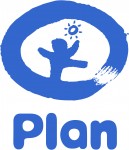Title: Livingstone to Lusaka (Zambia), World Bicycle Relief
Dates: 30th April to 4th May GPS:
Distance: 506km Total Distance: 14,266km
Roads: Good tarmac, high plains but hilly near Lusaka
Weather: Perfect - cool evenings, warm days - except for a nagging headwind
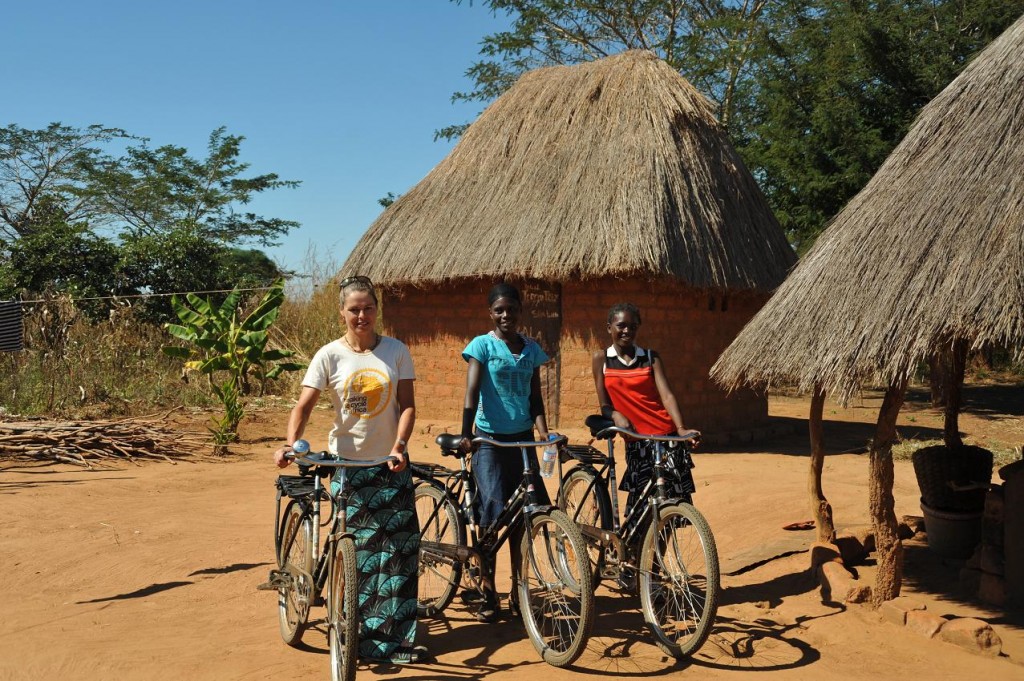
The journey from Livingstone to Lusaka was a pretty straight forward three and a half day ride up the main road. The Chinese have just about completed an upgrade of all the way to Monze (180km from Lusaka)…except for the first 50km out of Livingstone where we the route was a combination of rough diversions and old potholed tar. The quality of their work was much better in Zambia than in Angola. They were adding a much thicker layer of tar and taking care to protect it as the road was being built. At one point, I was given permission to cycle down the side of the new tarmac. It seemed dry enough for a start, but then my tyres started sticking to the road. Sticky black tar and gravel stones flicked up and caked the tyre tread totally. Being the end of the rainy season, the bush appeared fresh and alive with new growth and tall wispy veldt grasses. I really enjoyed cycling through this countryside, which my team thought appeared uninspiring from the vehicle.
The objective of the first day out of Livingstone was to reach MacRon’s, a well-known truck stop recommended to us by Tienie Kril, the South African truck driver whom we met in Angola. We were unsure exactly how far it was as he had just made a mark on our map, so when MacRon’s sign appeared about 12km north of Kalomo, 145km 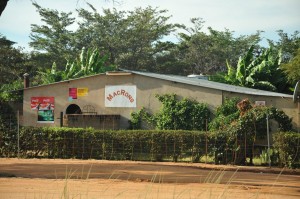 from Livingstone, I was very pleased. It was well worth the effort. Mac is a great character and his bar/restaurant is also brimming with atmosphere. If you like huge meals of steak, chicken or mixed grills with fried eggs and chips – then MacRon’s is for you. We were spoilt with the hugest meals which barely fitted on the enormous plates, balanced with a small token pot of coleslaw each. We watched a Super 14s rugby encounter with Mac and his other clients; Mac providing the meal and extra rounds of drinks on the house.
from Livingstone, I was very pleased. It was well worth the effort. Mac is a great character and his bar/restaurant is also brimming with atmosphere. If you like huge meals of steak, chicken or mixed grills with fried eggs and chips – then MacRon’s is for you. We were spoilt with the hugest meals which barely fitted on the enormous plates, balanced with a small token pot of coleslaw each. We watched a Super 14s rugby encounter with Mac and his other clients; Mac providing the meal and extra rounds of drinks on the house.
Every school has its advertising sign complete with school motto beside the road. I had noticed these ever since arriving in Zambia. The mottos were very good, many I found uplifting as I pushed into the breeze. One motto, for example was: ‘Education and hard work leads to survival and self-reliance’. Most were in a similar vein.
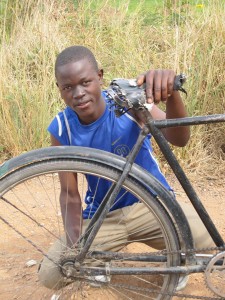 Zambia has a real cycling culture and many cyclists, especially boys and teenagers like to try to race me. Normally they amble along and so I pass them just going my usual pace. They respond with a burst of speed – not sustainable – and leave me in their wake. Once they have beaten me, the incentive is gone and their effort soon fizzles out. Their bikes are usually held together with whatever they can find, have pedals missing, buckled wheels, broken seats…and they are often carrying huge loads. On the final morning in to Lusaka, another young man zoomed passed me as I cycled through Kafue. As we hit the hill out of town, he struggled on his single geared machine and I caught him. We rode together for about 20km and had a great conversation while others followed for short distances and then peeled off. His name was Steve. I thought he looked about 15, but he said he was 12, although in year 9 at school. He seemed a very bright kid and said he wanted to be a lawyer when he grew up. Steve’s father died in 2006, I think from AIDS. His mother is a farmer and has to care for her ten children. She grows maize and sugar cane to sell to a local cooperative, but struggles to make ends meet. Steve said he was cycling to visit a friend just outside Lusaka but I thought he should have been at school, so I asked why. He explained that he hasn’t been able to go to school for the last month because his mother can’t afford the school fees. When the LandRover caught us I gave him something to eat and water. We made a few small improvements to the bike, Dan repositioning a piece of wood to stop the mudguards rubbing through the tyre.
Zambia has a real cycling culture and many cyclists, especially boys and teenagers like to try to race me. Normally they amble along and so I pass them just going my usual pace. They respond with a burst of speed – not sustainable – and leave me in their wake. Once they have beaten me, the incentive is gone and their effort soon fizzles out. Their bikes are usually held together with whatever they can find, have pedals missing, buckled wheels, broken seats…and they are often carrying huge loads. On the final morning in to Lusaka, another young man zoomed passed me as I cycled through Kafue. As we hit the hill out of town, he struggled on his single geared machine and I caught him. We rode together for about 20km and had a great conversation while others followed for short distances and then peeled off. His name was Steve. I thought he looked about 15, but he said he was 12, although in year 9 at school. He seemed a very bright kid and said he wanted to be a lawyer when he grew up. Steve’s father died in 2006, I think from AIDS. His mother is a farmer and has to care for her ten children. She grows maize and sugar cane to sell to a local cooperative, but struggles to make ends meet. Steve said he was cycling to visit a friend just outside Lusaka but I thought he should have been at school, so I asked why. He explained that he hasn’t been able to go to school for the last month because his mother can’t afford the school fees. When the LandRover caught us I gave him something to eat and water. We made a few small improvements to the bike, Dan repositioning a piece of wood to stop the mudguards rubbing through the tyre.
I had been warned about Zambian traffic, but up until Lusaka, it wasn’t too bad. Cycling into the city was predicably busy, but the traffic didn’t move very fast and in fact I would class Lusaka as one of the easiest cities to enter by bicycle so far. We made our way to my contacts at African Energy Resources, who kindly offered to put us up for a couple of nights. We are making a big pit stop in Lusaka with project visits and team changes.
First on the agenda was to meet Kristin and Dave from World Bicycle Relief, one of our expedition partners. Over a lovely dinner, they gave us a great introduction to WBR, its mission and projects. WBR’s mission is to provide access to independence and livelihood through “The Power of Bicycles”. Bicycles are providing simple, sustainable transportation as an essential element in disaster assistance and poverty relief. Bikes fulfil basic needs by providing access to healthcare, education and economic development, empowering individuals, their families and communities. WBR, founded by SRAM (BTC sponsor) and Trek Bicycles, began in response to the Boxing Day Tsunami, providing 24,400 bicycles over two years to a program in Sri Lanka. In 2006 WBR turned their attention to Zambia and since then they have established three different programs, with more projects being developed in other east African countries. Project Zambia began with WBR partnering the organisation RAPIDS (Reaching HIV/AIDS Affected People with Integrated Development and Support) to provide 23,000 bicycles to HIV/AIDS caregivers. With this program complete, they commenced the Bicycle Education and Empowerment Program (BEEP), the project is now in full swing, providing 50,000 bikes school students, targeting those who need it most; 70% to girls. Now WBR are partnering with the World Vision micro-finance organisation, Harmos, encouraging the use of bicycles as a means of developing economic/business opportunities.
The WBR bicycles are not donors’ throwaways; they are custom-built to withstand the challenging conditions in Africa and to meet the needs of the users. While many organisations believe they are helping developing communities by donating ‘normal Western’ bicycles, which have been perhaps gathering dust in the back shed, this is just a short term fix. Such bikes are not made for the conditions, finding replacement parts in Africa is impossible and they can cause animosity in communities because people receive different standards of bicycle. Most bikes in Africa, such as the one Steve was using, are a poor copy of the old Raleighs made in the 70s, nowadays usually made in China with nowhere near the quality and strength of the originals. The WBR bikes are basically work-horses; the design modified after feedback from the end users and continually reviewed. They weigh 21kg; the rack can carry 100kg. Everything about them is built to last. The bicycle components are chiefly sourced from TATA, an Indian bicycle company and arrive in Zambia as ‘complete knockdowns’ for assemblers to put together in Africa. 470 mechanics have so far been trained to ensure that if there is a breakdown, the bike can be fixed with existing supplies of parts shipped in from TATA. During their training course, mechanics are given a toolkit, uniform also trained in business principles and life skills and are located in villages where there are programs.
Kristin kindly arranged a special tour for Zdenek and I to see an example of each of these three projects and so the next day we were up early and off to the Chongwe District about 40km east of Lusaka. In Chongwe we collected Munangandu (Muna) who came along to help out and interpret. Firstly we set off on a track south of Chongwe to visit Chitentabunga Primary School which serves a zone of the same name containing eight villages. It was school holidays still, but the head and deputy head teachers, who normally work through the holidays made time to meet and welcome us. Here we met Evelyn and Fabby who are in years 8 and 9 respectively. They had cycled in from home to show us their new WBR bicycles as part of the BEEP Program. Fabby leant me her bike and I took it for a quick spin – so different from what I am used to with back pedal brakes and very upright cycling position that I felt like a beginner! It’s definitely a coaster…with an extremely comfortable seat.
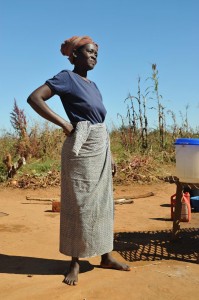 I cycled about 4km with the two girls back to Evelyn’s village to meet her family. We were also joined by Joyce, the religious education teacher. Once I could get some momentum, the bike seemed to handle even the sandy patches with ease. Evelyn’s mother has five children and is alone. Her husband died a few years ago (we suspect of AIDS, but not 100% sure) and so she did everything; grew maize, sugar cane, pumpkins and onions, she baked bread and sold her produce at the local market, brought up the family and is a care worker. In fact she qualified for a bicycle through the RAPIDS program a couple of years ago.
I cycled about 4km with the two girls back to Evelyn’s village to meet her family. We were also joined by Joyce, the religious education teacher. Once I could get some momentum, the bike seemed to handle even the sandy patches with ease. Evelyn’s mother has five children and is alone. Her husband died a few years ago (we suspect of AIDS, but not 100% sure) and so she did everything; grew maize, sugar cane, pumpkins and onions, she baked bread and sold her produce at the local market, brought up the family and is a care worker. In fact she qualified for a bicycle through the RAPIDS program a couple of years ago.
The 50,000 bicycles are being distributed in 500 schools to those in most need. Bicycles allow people to travel four times as far and carry five times the load compared to walking. Girls are a priority because they are usually required to work hard before school starts, and if they have to then walk 20km to and from school (as in some cases), either they miss class or are in trouble because they are late. Girls are the most vulnerable from harassment and sexual abuse during their long journey. Reducing the travel time limits the problem and encourages them to go to school. In Zambia, only 17% of girls complete their secondary education. WBR have partnered with the Zambian Ministry of Education, community-based organisations and a number of NGOs to ensure the bikes are directed to the right people, their use is monitored and feedback acted upon. As long as the WBR bikes are used for the intended purpose, they may be used also as a means of transport by the family.
Evelyn appeared so proud that she had been chosen to show us how she used her new bicycle. As we were leaving her mother tried to give me a sack of sweet potatoes she had grown – as if she didn’t give enough already! I felt very humble and insisted she keep them for her own use or to sell as “I did not have anywhere to cook them”. Instead she gave them to Joyce, the teacher. At least she would make better use of them.
Next on the schedule was a visit to meet a health care worker who qualified to receive her bike during the RAPIDS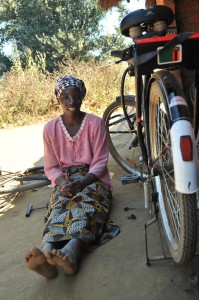 initiative. Muna and Irene, project coordinators, took us to see Jennifer. Like Evelyn’s mother, Jennifer already leads a full life let alone volunteering to care for 28 people on a regular basis. She received her training back in 2006, which included a basic medical kit and counselling instruction. Carers like Jennifer are their community’s first port of call if someone needs help. If someone needs more serious medical attention, she can refer and encourage them to get to a hospital. Using her bicycle, Jennifer is able to attend more patients more often and give more quality time than if she was on foot. The bicycle has increased her productivity immensely. She has also improved her own economic circumstances. One of Jennifer’s patients lived next door, (many are much further away) so she took us to meet Emma. Irene explained that Emma nearly died of AIDS. Unable to eat because of the sores on her throat, she had almost gone when they took her to be diagnosed and receive treatment. Now she can have a productive life again, even starting to work in the fields thanks to the right ARV medication. Jennifer still cares for her as a home help. Emma was joking and upbeat and it was wonderful to see how she was able to contribute to her family and community again.
initiative. Muna and Irene, project coordinators, took us to see Jennifer. Like Evelyn’s mother, Jennifer already leads a full life let alone volunteering to care for 28 people on a regular basis. She received her training back in 2006, which included a basic medical kit and counselling instruction. Carers like Jennifer are their community’s first port of call if someone needs help. If someone needs more serious medical attention, she can refer and encourage them to get to a hospital. Using her bicycle, Jennifer is able to attend more patients more often and give more quality time than if she was on foot. The bicycle has increased her productivity immensely. She has also improved her own economic circumstances. One of Jennifer’s patients lived next door, (many are much further away) so she took us to meet Emma. Irene explained that Emma nearly died of AIDS. Unable to eat because of the sores on her throat, she had almost gone when they took her to be diagnosed and receive treatment. Now she can have a productive life again, even starting to work in the fields thanks to the right ARV medication. Jennifer still cares for her as a home help. Emma was joking and upbeat and it was wonderful to see how she was able to contribute to her family and community again.
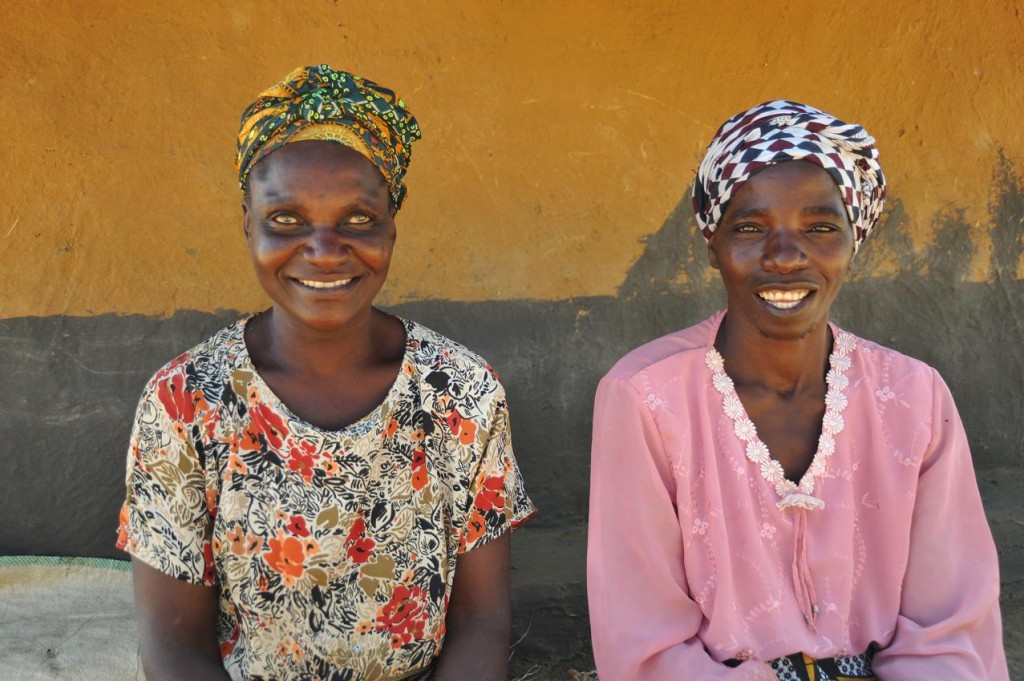 The third initiative which supports economic development through micro-finance loans for bicycles seems to be the way WBR is heading – creating sustainable businesses. The WBR bikes cost around $US150 each, beyond the means for the average villager. When a person, or often a small group of people decide they have a need for a bike, they can make an appointment with the staff at Harmos, a micro-lending bank. Typically they need to contribute a third of the amount, and with a guarantee from the village headman can secure a $100 loan. The loans must be repaid within 3-6 months and currently about 89% are honoured within the time frame. I had a chat with James Phiri at the loans office,
The third initiative which supports economic development through micro-finance loans for bicycles seems to be the way WBR is heading – creating sustainable businesses. The WBR bikes cost around $US150 each, beyond the means for the average villager. When a person, or often a small group of people decide they have a need for a bike, they can make an appointment with the staff at Harmos, a micro-lending bank. Typically they need to contribute a third of the amount, and with a guarantee from the village headman can secure a $100 loan. The loans must be repaid within 3-6 months and currently about 89% are honoured within the time frame. I had a chat with James Phiri at the loans office, 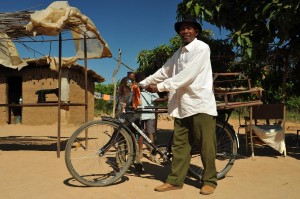 who then took us to meet Joe – to showcase the initiative. Joe seems unstoppable. He used his first bike to carry charcoal to Lusaka to sell. He said this is all he did for six months – put his head down and worked. With the money he saved, he was able to buy another bike. Within two years he now has six businesses. His incentives are to plan ahead so that when he is too old to push the pedals, he has an income and his family a decent inheritance. The notion of such forward planning is rare in Joe’s culture. Joe showed how he attached the special goat cage to the carrier so he can transport his goats to market. He has bought more land on which he and his family grow vegetables to eat and sell. He rents the properties he has bought and on the day we visited he had just bought another sewing machine. He plans to employ six tailors to produce clothes. We all sat under a shady tree where initially Joe explained how with the loan giving him a leg up, he has created so much. However, when Joe learned what I was doing, roles were reversed. He asked many very thoughtful and appropriate questions. Joe is a great advertisement for the program as he tells everyone with such enthusiasm how to do what he has done. I think we inspired each other!
who then took us to meet Joe – to showcase the initiative. Joe seems unstoppable. He used his first bike to carry charcoal to Lusaka to sell. He said this is all he did for six months – put his head down and worked. With the money he saved, he was able to buy another bike. Within two years he now has six businesses. His incentives are to plan ahead so that when he is too old to push the pedals, he has an income and his family a decent inheritance. The notion of such forward planning is rare in Joe’s culture. Joe showed how he attached the special goat cage to the carrier so he can transport his goats to market. He has bought more land on which he and his family grow vegetables to eat and sell. He rents the properties he has bought and on the day we visited he had just bought another sewing machine. He plans to employ six tailors to produce clothes. We all sat under a shady tree where initially Joe explained how with the loan giving him a leg up, he has created so much. However, when Joe learned what I was doing, roles were reversed. He asked many very thoughtful and appropriate questions. Joe is a great advertisement for the program as he tells everyone with such enthusiasm how to do what he has done. I think we inspired each other!
We returned to Lusaka and met everyone in the WBR office before Kristin dropped us back home. I thank Kristin Tweardy, Dave Neiswander and the team at WBR for such wonderful hospitality and taking the time to educate me about their programs and vision.
The following day, 5th May, Zdenek and I took a flight to Lubumbashi in the south east corner of the Democratic Republic of Congo for a two day visit to the Kinsevere mine site where Ausenco, a gold sponsor are building a copper mine for Anvil Mining.
I’ve also included in this entry a short video which Zdenek has made of our little tour of Waza National Park in northern Cameroon. We didn’t get to see that much but you still get a good idea of what the team has been getting up to on our days off.
The main collection of photos accompanying this blog will be uploaded in the next day or so.

